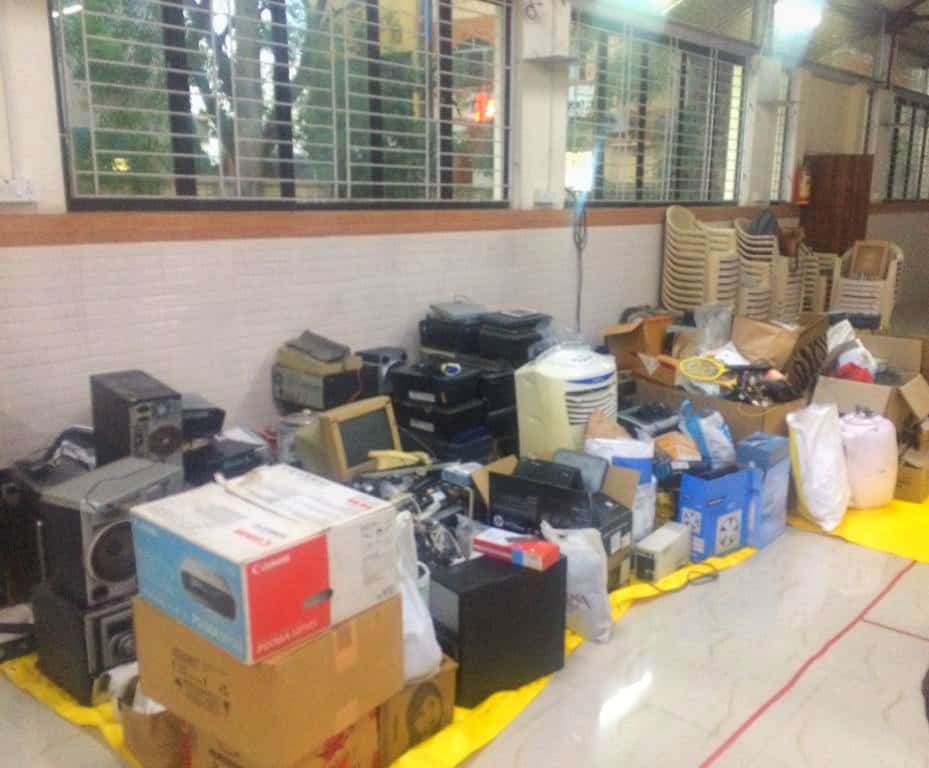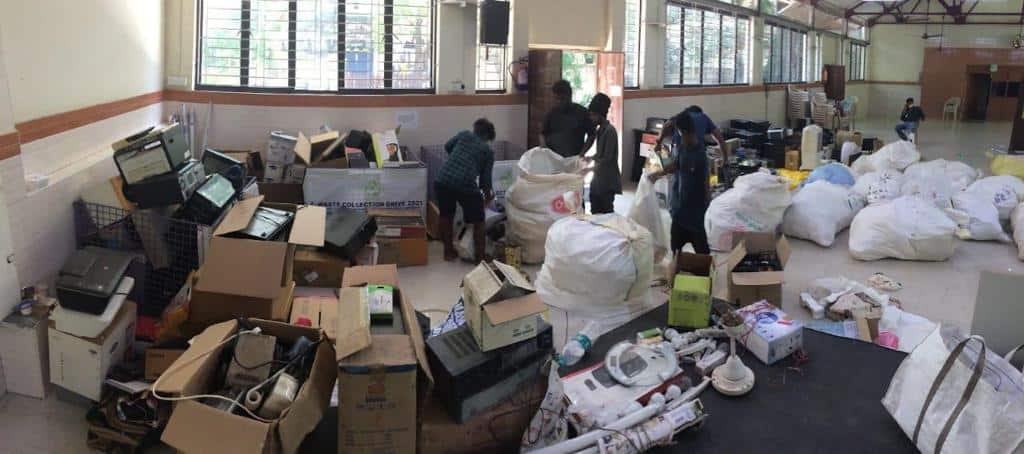It would be an understatement to say that humans are dependent on their electronic gadgets or devices. In this day and age of work from home and e-learning, where the pandemic has ensured that individuals and families spend most of their time within the four walls of their homes, it is safe to say that we’re all hooked on to some or the other electronic appliance, one way or the other. However, the question remains as to what happens to these electronic or electrical devices once their shelf lives are over? That is, when they have been reduced to ‘e-waste’?
According to reports, India is now the third largest generator of electronic waste or e-waste in the world, after the United States of America and China. As per the Central Pollution Control Board’s (CPCB) annual report for the financial year 2019-20, India is said to have generated a total of 10,14,961 tonnes of e-waste during the year. And the data put out by the Tamil Nadu Pollution Control Board (TNPCB) says that the southern state has generated a total of 28,305.89 tonnes of e-waste during the year 2020-21.
Although TNPCB records do not specify the amount of e-waste collected in the city of Chennai alone, a study published by the International Journal of Science Technology & Engineering in 2016 states that Chennai produces over 4,000 tonnes of e-waste every year.
So what is e-waste? According to the E-Waste (Management) Rules, 2016, published by the Ministry of Environment, Forest and Climate Change, Government of India, it includes electrical and electronic equipment (including computers, laptops, printers including cartridges, cell phones, television sets, refrigerators, washing machines, air conditioners, fluorescent and other mercury containing lamps) which are discarded as whole or in part as waste by a consumer or bulk consumers or as discarded during the manufacturing or repairing process.
Read more: Indian cities stare at a mountain of e-waste, with little idea of how to manage it
These e-waste items can be classified as hazardous or non-hazardous depending on the materials they are made of. And most of these items also consist of elements like mercury, lead, zinc etc. which means that one has to be careful when it comes to disposing it off, as it poses the threat of environmental and health hazards.
What do the e-waste rules say?
To manage and control the inefficient disposal of e-waste in the country, the Ministry of Environment came up with the E-Waste Management rules in 2016, which spells out the responsibilities of various stakeholders regarding the safe management and disposal of electronic items once their use is over.
Responsibilities of the producers of electrical and electronic equipment
As per the rules, the producer of the equipment shall be responsible for the collection of e-waste from the “end-of-life” of their products under the Extended Producer Responsibility (EPR) framework. EPR creates a policy framework in which producers are given significant responsibility for the disposal of the products they manufacture, once they have ceased to be of use.
The producer also has the responsibility to ensure that no damage is done to the environment during the process of transportation and storage of e-waste. It shall also maintain a record of the e-waste generated, handled and disposed of and make such records available for scrutiny by the concerned pollution control board of a state.
Responsibilities of Refurbisher, Dismantler and Recycler
The e-waste management rules state that only those vendors that have received authorisation from the state pollution control board can refurbish, dismantle or recycle electronic and electrical equipment. In the case of Chennai, these vendors need the authorisation of TNPCB. These vendors also have to ensure safety for the environment as well as maintain a record of the e-waste generated and disposed of.
What happens in Chennai?
As far as Chennai is concerned, it is safe to say that the concept of EPR mentioned in the e-waste management rules is non-existent. In Tamil Nadu’s state capital, the responsibility of overseeing the disposal of solid waste lies with the Greater Chennai Corporation (GCC) and according to a senior engineer of the municipal body, they do not have separate collection mechanisms for e-waste in the city.
“We don’t get such huge quantities of e-waste on a regular basis from the residents,” states the engineer. When asked what someone should do in case they have to dispose of some of their electronic items or equipment, the GCC official said that they can drop them at the domestic hazardous waste collection centres, which are present in each zone in the city. From these centres, the e-waste items are collected by recycling vendors which are authorised by the TNPCB. You can find a list of TNPCB authorised e-waste dismantlers and recyclers here.
However, several experts who study waste management closely in the city corroborated what the GCC official said and stated that only very few citizens make use of these collection centres for the disposal of e-waste. Even where citizens are aware, they find it unfeasible as the Corporation cannot keep these centres open late at night or on weekends, which would be a more convenient time for working citizens to dispose of their e-waste.
“As far as collection of e-waste is concerned, there are not many private or even government agencies that do this in Chennai and it is mostly done by NGOs or Residents Welfare Associations,” says Vijay, founder of Trashman, a waste management company in the city. As a result, he says, one can often find discarded cables, mouse and keyboards and other such items if they dig through the various corporation trash bins in every locality.
“The problem is that the residents, including those highly educated, are not aware of how to dispose of these e-waste items or the fact that that they can be recycled or refurbished. They just throw it out along with other plastic or food wastes,” adds Vijay. These discarded items are then picked up by the informal waste pickers.
“95% of domestic e-waste in Chennai is handled by the informal sector, in the form of kabadiwalas and so on. While they go door to door collecting scrap like papers, cardboard and stuff, households sometimes hand over some of their e-waste as well. What the kabadiwallas do is that they manually break these electronic equipment and take the plastic or metals out of it, which they then sell to scrap vendors for some meagre amount,” says Mathew Jose, founder of Paperman, a waste management organisation based in Chennai.
The bigger companies and industries have tie ups with professional waste recycling units, which is a feasible arrangement since companies tend to generate large amounts of discarded electronic and electrical devices.
Health and environmental hazards
As mentioned above, most of the e-waste in the city is handled manually by the informal sector, where the items are dismantled to recover the reusable parts like plastic and metal. In an earlier report by Citizen Matters, Sayed Mohammad Tauseef, a professor at University of Petroleum and Energy Studies (UPES), Dehradun, was reported to have pointed out that such uncontrolled processing results in the release of large amounts of pollutants into the atmosphere and exposes workers to great health risks.
Most of the workers who deal with such e-waste in the informal sector extract metals by dipping the equipment in acid and they do this without any protective gear, which exposes them to the risks of suffering from burns and skin ailments. The common practice of burning the plastic coating of cables, circuits and coils to extract metals like copper leads to the release of pollutants like polyvinyl chloride, which can cause damage to the nervous system and lungs.
There is also a risk of elements like mercury, lithium, lead and barium leaking from the equipment and seeping in through the earth into groundwater. This acidifies the water and makes it toxic, making it unsafe for communities, animals and plants of that region.
Citizen initiatives
Due to the absence of a regular collection system of e-waste in the city, several citizen groups and associations have begun to come up with initiatives to collect and dispose of e-waste, at least in their immediate localities. One such initiative was undertaken by the Residents of Kasturba Nagar Association (ROKA), which has organised several e-waste collection drives over the past couple of years, for which it was also praised by the former GCC Commissioner, G Prakash.
“We started off with door to door awareness in 2018 on solid waste management, where we were informing the residents of Kasturba Nagar about the need to segregate waste and so on. We noticed that people did not know what to do with items like batteries and tube lights. They would just drop it in one of the bins,” says Janani Venkitesh, secretary of ROKA.
Following ROKA’s awareness campaign in 2018, they understood the need for a proper way to dispose of their e-waste. So they started organising bi-annual collection drives. They organised an e-waste collection drive for the residents of Kasturba Nagar in 2019, where they collected 750 kg of e-waste, which they handed over to the corporation. In 2020, a three-day collection drive was organised where they collected close to 105 tonnes of e-waste. But this time it was not just restricted to Kasturba Nagar.
Meanwhile, the Indian Institute of Technology (IIT) Madras is coming up with another innovative model to tackle the issue of e-waste disposal, by creating a platform that will help in tracking the circularity of these e-wastes. Known as e-source, this initiative is spearheaded by the Indo-German Centre for Sustainability (IGCS). Speaking to Citizen Matters on the same, Jagan, one of the members of IGCS said that “Chennai is a big hub in India as far as e-waste is concerned, but no one is thinking about how to recover such huge amounts of waste and use them for some other purpose.” This is where e-sources come into play as it connects the different buyers and sellers of Used and Waste electronic equipment and components.
‘Need a better collection system’
One of the points raised by most of the people working with e-waste in the city is the need for an efficient and safe collection system of e-waste in the city. “It would be better if there was a point or a kiosk in each zone or ward where the residents can go and drop their e-wastes,” suggests Janani. She feels that not every resident will hold on to their e-waste and wait for a collection drive to happen, so with kiosks like this, they can do so at their convenience, whenever they want.
Jagan feels that compared to the volume of e-waste that is generated in the city, hardly any percentage of it is collected and sorted for recycling or recovery. “What could eventually evolve into a more efficient collection system is to potentially deploy these smart bins in different parts of the city. They can then basically track what you are dropping into the bins, through different sensor learning technologies. Those are already there for plastic in different parts of the world.”

